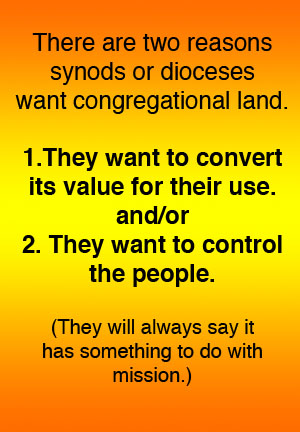Why Congregations Should Own Their Buildings: Part 1
Why Congregations Must Own
Their Ministries
(and that includes property).
 Part 1
Part 1
A long time ago there was a church that had lost its way. It had many members. Almost every person in every city and hamlet belonged.
Each town had its own monument to God. These monuments were built by the people. The land was likely part of a tract of land provided by a local baron, who might have received his land as a reward for a winning role in a crusade.
The people built the resulting church or cathedral. Some laid the foundations and built the walls, some designed windows of rainbow beauty. Others made the hardware that hung the doors and secured the roof. Others carved the pews and illustrated the stories of their faith on the wall. Still others waited until the roof was complete to install the musical instruments for their best musicians to play.
And then there were the women who kept the homes going, the workers fed, the linens woven and held the hands of the many children they brought through its doors. It took several generations to make these splendid monuments to God.
These monuments became extensions of their homes. They were nurtured at their altars in their youth, strengthened through the years, and comforted in their old age.
They loved the buildings and what they meant to them, but they did not own them.
Absentee Landlords
Their churches were owned and controlled by leaders, far away on the other side of formidable mountains.
Church officials did not trust the people to own their own buildings. Their work was acceptable to God, but it was owned and controlled by hierarchy which tended to appoint and elect people who would comply and obey.
What was presented to the glory of God was used to glorify Man.
This system worked very well as long as everyone agreed on everything and there were enough people willing to enter lives of total compliance to sustain the structure. For centuries most people’s choices in life were made for them by the station of their birth. Change was seldom seen and challenges came from outside the faith.
Things Started to Change
Suddenly, the challenges of this lifestyle came not from infidels but from the faithful. How would the Church handle its own dissenters?
The knowledgeable religious began to see that sole ownership of the church by a corporate office in Rome was abusing the faithful. The Church had become a vehicle for personal advancement. Expensive lifestyles were sustained with the sacrifices of much poorer people. They were being gouged— charged even for prayer.
People wanted to believe that the Church they loved had their best interests in mind. They relied on trust—most messages from their leaders were delivered in a foreign tongue.
Then came Martin Luther and Gutenberg (among others).
He told them what was going on in their own language.
His printed message spread across Europe, uncensored by the Church for the first time.
Many of the faithful were kicked out.
Lucky! For the first time, they had some place to go!
The Church in a New Land
Many traveled to a New Land where immeasurable property was newly available. For the first time the people could actually own the property they donated and the buildings they raised. They could affiliate with a Church later.
The old system still exists today. It is failing fast. The Roman Catholic Church and the Episcopal Church still own all church property. Both bodies are closing churches at a record pace. The Episcopal Church is fighting many court battles over property. The Roman Catholic is being eaten alive in our area by the clergy sexual abuse scandals.
Some of this is because of the failing support and lawsuits. Some is control of their people. Disagree with the Church. We will take the property you built and paid for.
The Lutheran Church and other Protestant Churches, grounded more firmly in the spirit of the Reformation and growing in a new land, did not attempt to accumulate property for the benefit of a corporate church. There would be no grand collections of art and treasuries to collect the sacrificial offerings of the faithful for the benefit of clergy. We had left that thinking behind.
Protestant Churches of many sects prospered under this new system.
Early Lutherans in the New World forbade church hierarchy from owning property. They wanted to ensure that the officials of the church existed to serve not accumulate wealth.
But today the church is in trouble again. The Lutherans spent a good part of recent decades trying to unite with the Episcopal Church. They are now proudly in Full Communion (minus the long list of exceptions and disclaimers that follow the documents that most people don’t read). Full communion, sort of.
One reason today’s Lutheran bishops are comfortable claiming congregational property is this new association with Episcopal Church. In doing so, they are reverting to pre-Reformation thinking—the thrilling days of yesteryear when hierarchy controlled more than they led.
We’ll look at what this means for today’s Lutherans in an upcoming post.
